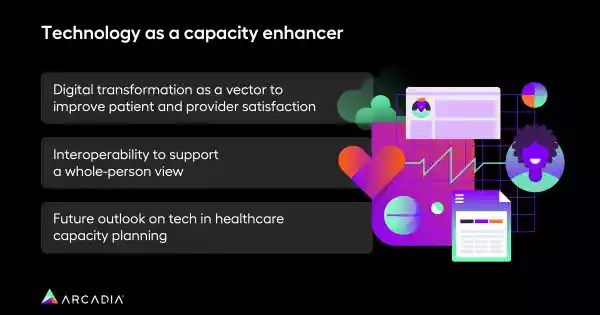Mind the gap: How to navigate capacity challenges in healthcare
Learn how to address capacity challenges head-on, improve patient care, and pave the way for a more efficient and effective healthcare system.
Healthcare providers face many challenges that test their ability to deliver care. These hurdles, including clinician shortages, rising operational costs, and the ongoing shift towards value-based care, demand a reimagined approach to healthcare delivery.
Michael Meucci, President and CEO of Arcadia, and Josh Kahane, MD, CEO of HealthHelper, discussed this topic in a byte-sized insight.
"Across the country, payers and providers are reexamining the risk balance that exists in their contracts. Payers want to shift risk performance [to] providers. Providers are trying to stay afloat."
Michael Meucci – President and Chief Executive Officer at Arcadia
This article covers strategies and actionable insights for healthcare leaders who are ready to overcome these obstacles through innovation, collaboration, and the strategic use of technology.
Embrace the pressure to innovate
Healthcare is in the hot seat. Primary care and specialty shortages, along with higher patient costs, are adding to the problem. Also, the never-ending complexities in payment models are impacting the entire industry.

Contracts are getting more complex. Providers have an average of 16 to 20 different contracts, and on top of that, they see 20 to 30 patients a day. They really need help in this area.
This pressure on the US healthcare system is immense, but it can also drive transformation. It is necessary to face these challenges head-on. While daunting, this pressure can be a strong catalyst for innovation, pushing the healthcare sector towards efficiency and excellence.

Healthcare leaders can view these challenges as opportunities for growth and transformation. Although it is difficult now, this opportunity can pave the way for a healthcare system that is resilient and responsive to patient needs. By keeping this upside in mind, what can help providers navigate the capacity challenge that exists today?
The power of collaboration and technology
The solution to capacity challenges requires a collaboration between healthcare providers, payers, and technology vendors. This trio can foster a more integrated, efficient, and patient-centered healthcare ecosystem.

An example of these strategies at work is Arcadia’s national incentive to get more patients vaccinated for HPV. By addressing the challenge of vaccine administration at scale, the strategic use of technology and innovative scheduling powered by AI can overcome traditional barriers that impact public health.
Collaboration with technology stands as a cornerstone in reinforcing patient loyalty within healthcare. Without contractual incentives for vaccination rates, providers must look elsewhere for solutions. By harnessing technology vendors and provider networks, AI can unlock new possibilities. It can identify patient cohorts needing vaccinations, allowing for the organization of targeted "vaccination days."
This streamlines the immunization process by engaging 100 or more individuals. It also nurtures patient-provider relationships. As a result, patients are less likely to seek vaccinations outside of their primary care organization, which could lead to fragmented care and disjointed health data. This holistic approach not only cleanses data streams but also aligns with provider contracts, promoting better patient and population health outcomes.
Actionable strategies for healthcare leaders
To navigate the complex landscape of capacity challenges in healthcare, providers can adopt several strategies:

1. Foster strategic partnerships
Engage in meaningful collaborations with payers and technology vendors to bridge gaps in care delivery and streamline the transition to value-based care. These partnerships can provide the necessary support and resources to innovate and improve patient outcomes.
2. Leverage technology for enhanced engagement
Implement AI and digital tools to automate patient engagement and administrative tasks, freeing up valuable resources to focus on direct patient care. Technology can also ease personalized care coordination and improve the overall patient experience.
3. Innovate to overcome capacity limitations
To address capacity limitations, adopt flexible and innovative approaches to care delivery, such as pop-up clinics and dedicated vaccination days. Use technology to match patient demand with provider availability, ensuring efficient resource use.
4. Focus on measurement and improvement
Continuously measure performance and outcomes to identify areas for improvement. Use data and analytics to inform decision-making and optimize care delivery processes for a higher standard of care.
5. Prioritize patient-centered care
Above all, the focus should remain on delivering patient-centered care. Tailor healthcare experiences to meet individual patient needs, ensuring access to timely and effective care. Embrace the role of technology not only as a tool for efficiency but to enhance the quality of care and patient satisfaction.
A future of integrated healthcare solutions
The journey toward navigating capacity challenges in healthcare is complex, requiring a comprehensive strategy that embraces innovation, collaboration, and the use of technology. By implementing these strategies, healthcare providers can address the current challenges head-on, improve patient care, and pave the way for a more efficient and effective healthcare system.
The collective effort to transform healthcare delivery through technology and partnership signifies a shift towards a more responsive and patient-focused healthcare model. Healthcare providers can not only overcome current obstacles but also set the foundation for a future where quality, efficiency, and patient satisfaction are at the core of healthcare delivery, ensuring a healthier tomorrow for all.
Learn more about how new technology partnerships can relieve provider capacity challenges or schedule a demo.
